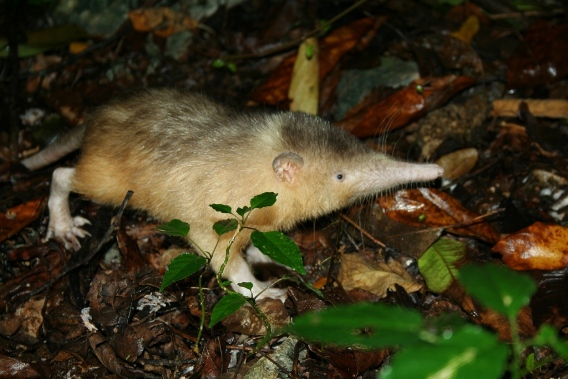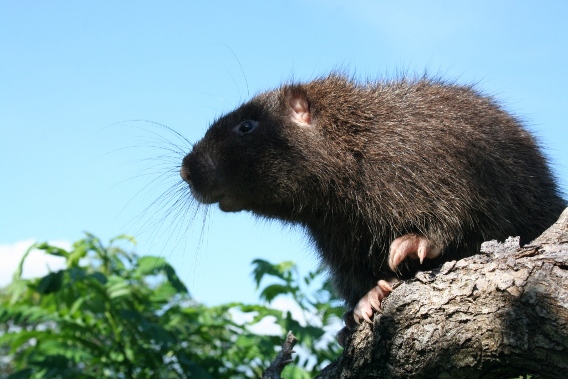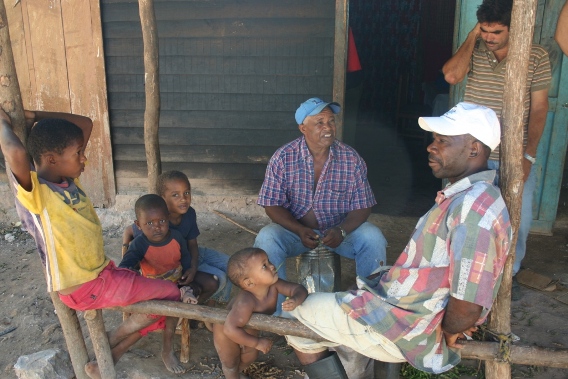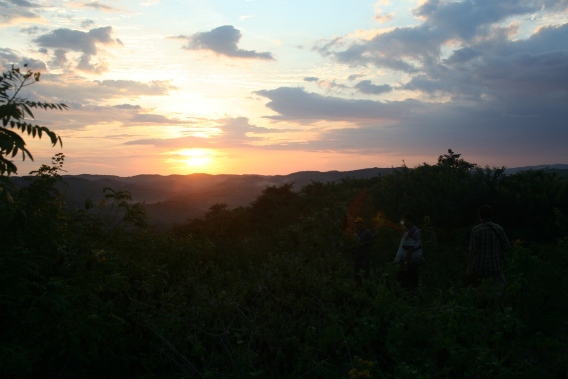Not many people know the solenodon and the hutia, yet for the fortunate few that have encountered them, these strange little-studied mammals—just barely holding on in the Caribbean island of Hispaniola—deserve to be stars of the animal kingdom.
“I could not quite believe it the first time I held a solenodon; I was in utter awe of this mesmerizing mammal. […] They have a long flexible snout which is all down to the fact that it is joined to the skull by a unique ball-and-socket joint. This makes it look as if the snout is almost independent to the rest of the animal. You can’t help but feel fascinated by the snout and inevitably it does make you smile,” Dr. Jose Nunez-Mino, the Project Manager for a new initiative to study and conserve the island’s last mammals, told mongabay.com in an interview. “When handled properly they are remarkably docile and relaxed which makes it very easy to observe them in the hand. […] All in all I think it is fair to describe solenodon as amazingly cute. They have a toy like quality about them which is reinforced by their very small eyes and their cumbersome walk which is more of a side to side waddle.”
The hutia may not be as odd or cute as the solenodon, but Nunez-Mino ensured mongabay that the hutia was just as special as the solenodon.
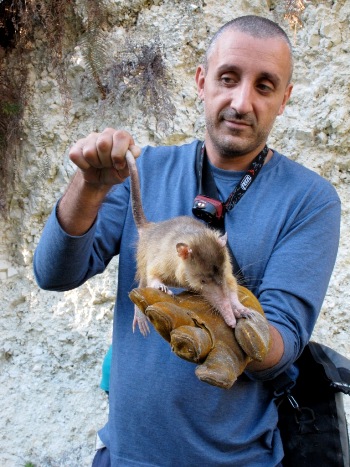 Dr. Jose Nunez-Mino with the wonderfully strange Hispaniolan solenodon. Photo by: Philip Bethge of Der Spiegel magazine. |
“A colleague and friend of mine once described hutia as looking like guinea pig but fatter which is not a bad description […]. They are very large rodents which usually have brownish fur (the colour can vary in some individuals and populations) which covers their whole body apart from their short tail which is a under a third of their body length. They have broad heads and short rounded ears – very teddy bear like in my eyes,” says Nunez-Mino.
Nunez-Mino is heading up a new initiative to not only better understand these last survivors of Hispaniola, but also to find effective ways to save them. The initiative, known as the Hispaniolan Endemic Land Mammals Project, is being funded by the UK government’s Darwin Initiative with partners including the Durrell Wildlife Conservation Trust, the Zoological Society of London and EDGE, the Sociedad Ornitologica de La Hispaniola, and the Dominican Republic National Zoo.
Although little-known both the solenodon and the hutia are important due to their unique evolutionary history.
“The solenodon represents an ancient lineage of mammals that has been around since the time of the dinosaurs – in all effects it can justifiably be described as a living fossil. […] Its most distinctive feature and one that causes a lot of interest is the fact that it can secrete venom along a grooved tooth (the word solenodon derives from the Greek for channelled tooth) in a manner similar to snakes,” explains Nunez-Mino.
The Hispaniolan hutia for its part “is the only surviving member of the Plagiodontia genus which is the oldest lineage of hutia and diverged from the other hutia around 20 million years ago. It is, undoubtedly a very special animal.”
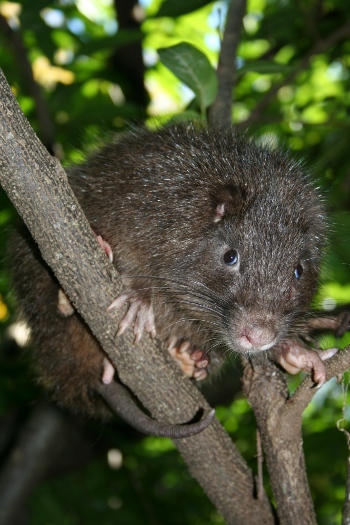 Hispaniolan hutias are arboreal mammals, spending their awake-hours (during the night) in trees. Photo by: Jose Nunez-Mino. |
Already Nunez-Mino and his colleagues have uncovered important information about both the solenodon and the hutia, especially the role sounds may play in their behaviour.
Solenodons make “a series of clicks and high pitched whistles,” says Nunez-Mino, “there has been some suggestion that these may be implicated in echo location but as far as I know there has been no conclusive work in this area. We have managed to make some initial crude recordings of the solenodon which have roused a lot of interest with scientists that work in this area.”
“Hutia produce a series of whistles and chirps with their alarm calls having more of a chortling quality about them. Sound is obviously very important for the Hutia, on quiet night you can hear them whistling to each other in the tree tops,” says Nunez-Mino, who hopes to find acoustic experts to study the sounds (the mammals’ sounds can be heard in videos at the end of the article).
So little is known about these two mammals that researchers are unclear about what is threatening them. It’s not that there is a lack of threats to choose from—deforestation, conflict with humans, poisoning, introduced species like mongoose, feral dogs, hunting—however determining which threats are most pressing is not easy.
While Haiti has lost nearly all of its forest cover (only 4 percent remaining), the Dominican Republic retains 28 percent of original forest cover and has large protected areas, though these areas do not protect the species from invasive and domestic animals: Nunez-Mino has heard unsettling accounts of feral dogs preying unmercifully on solendons. For the hutia deforestation could be particularly troubling, since the large rodern spends most of its awake-time in trees. Hutias have also been hunted in the past.
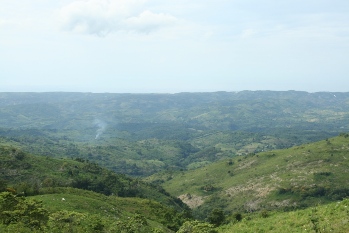 A view of the largely deforested Haiti, smoke is from burning charcoal. Photo by: Jose Nunez-Mino. |
However, Nunez-Mino explains that “right now I would say that it is our lack of knowledge that is posing the biggest threat.”
To save these wonderfully weird mammals “we need to both raise awareness as widely as possible not just at the national level but at the international one too. For the project to reach and continue into the future we want as many individuals or organisations as possible to get involved. […] Awareness raising can be done at many different levels, from having conservation issues as a topic of conversation or discussion, through to the more personal contribution of volunteering and experiencing conservation work in the field first hand,” Nunez-Mino says adding that interested people can follow his blogs on the Durrell Wildlife Conservation Trust website or the EDGE website, or join the Facebook group devoted to the project.
In addition, Nunez-Mino states that interested parties should feel free to contact him at: Jose.Nunez-Mino (at) durrell.org and a new project website has been set up at: http://www.thelastsurvivors.org/.
“Unlike all the other endemic non-flying land mammals of Hispaniola that have gone extinct, these two species have survived against the odds and are still with us,” explains Nunez-Mino. Hopefully the project will be able to keep it that way.
In a January 2010 interview, Mongabay spoke with Jose Nunez-Mino about the solendon and the Hispanolian hutia, including what it was like to encounter the mammas in the wild, their unique places in evolutionary history, the interest in their respective calls, and the threats to their long-term survival.
INTERVIEW WITH JOSE NUNEZ-MINO
Mongabay What is your background?
Jose Nunez-Mino: Although born and raised in London (United Kingdom), my parents are of Spanish origin and as a child I would return to rural north-west Spain (Galicia) every year to spend the summer with my extended Spanish family. It was during these periods that my love of the natural world was born and blossomed. I particularly remember the conversations with my maternal grandfather, who had been a farmer and hunter all his life, where he would tell me how in his life time he had witnessed the disappearance of great swathes of forest along with the reduction in numbers of the species associated with them. One particularly poignant story he never tired of telling was the fact that he had seen his last wild deer in the area where he lived in 1940, the year my mother was born.
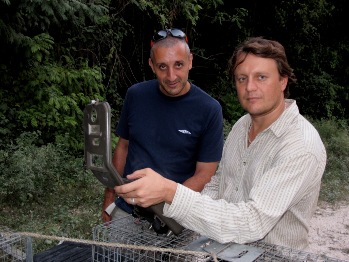 Dr. Jose Nunez-Mino and Jorge Brocca with camera traps. Photo by: Philip Bethge of Der Spiegel magazine. |
I did not, by any means, take a traditional route into conservation although as I have explained it has been in my blood from an early age. I did my undergraduate degree in life science at the University of Westminster and specialised in Ecology. At the end of this I became rather disillusioned with academia, particularly because a lot of it seemed too separated from the world at large, so I ended up going into the world of business. I eventually became a company shareholder and director. Throughout this time I continued my interest in nature and science while working on a voluntary basis with a variety of small UK based conservation charities which included the British Trust for Conservation Volunteers (BTCV), PlantLife International and The Woodland Trust, amongst others. Valuable lessons were learnt during this period of my life too and in particular I became aware of how important research is in terms of driving good policy and management decisions. This drove me to return the world of research so I enrolled to do a part-time Masters in Environmental Science at Birkbeck College (University of London). I had been out of the academic world for over 12 years by then but I found many of the business skills I had gained stood me in good stead. Over the duration of the course I became very conscious of the desperate environmental situation in many tropical countries. In the middle of my masters I enrolled on an expedition training course with Frontier. I spent six weeks in Madagascar where I witnessed the scale of destruction along with a real understanding of what we are at risk of losing. I was hooked and my vocation to pursue a career in tropical conservation was unstoppable. The following year after finishing my masters I was offered a sponsored place to do a second masters in Forest protection and conservation at Imperial College, London. I ended my business career then and there. I did my masters thesis in Parque Nacional Cususo (Honduras, Central America) with Operation Wallacea. After finishing my Masters I continued to do research in Parque Nacional Cususo for the following five years, initially on a freelance basis and subsequently as part of my PhD at the University of Oxford in “Biodiversity Indicators and Conservation Priorities”. I have not looked back since.
Mongabay How did you become interested in the solenodon and the hutia?
Jose Nunez-Mino: In 2009, as I was coming towards the end of my doctorate, I began looking for a post that would combine and make use of both my research/science skills in addition to my other life skills (management, logistical, people, negotiation and diplomatic). I knew I did not want to go into a postdoc since I wanted my work to be in the context of achieving concrete results in the real world. The Darwin initiative funded project working for the Durrell Wildlife Conservation Trust (DWCT) in collaboration with other organisations offered me just such an opportunity. I must admit, up to this point I had very little knowledge of these two species apart from the big solenodon news story that had been reported by various news media including the BBC and mongabay earlier in the year. When I started to do some background reading into both species I was amazed at how little work had been done previously. For such charismatic and unique species, our knowledge of their biology, ecology, behaviour and conservation status is remarkably limited.
THE SOLENODON
Mongabay What makes the Hispaniolan solenodon so unique?
Jose Nunez-Mino: There is so many ways that this question can be answered. From a conservation perspective they are unique because, along with the hutia and unlike all the other endemic non-flying land mammals of Hispaniola that have gone extinct, these two species have survived against the odds and are still with us. Additionally the Hispaniolan solenodon is also one of only two surviving insectivores from the Caribbean, the other being the related Cuban solenodon.
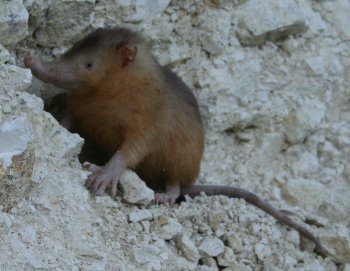 A juvenile Hispaniolan solenodon. Photo by: Jose Nunez-Mino. |
From an evolutionary perspective the solenodon represents an ancient lineage of mammals that has been around since the time of the dinosaurs – in all effects it can justifiably be described as a living fossil. Along with its surviving Cuban cousin they make up the Solenodontidae mammal family. Its most distinctive feature and one that causes a lot of interest is the fact that it can secrete venom along a grooved tooth (the word solenodon derives from the Greek for channelled tooth) in a manner similar to snakes although the incisors that do this are on the lower rather than upper jaw.
Mongabay What was your reaction when you first found a wild solenodon?
Jose Nunez-Mino: I could not quite believe it the first time I held a solenodon; I was in utter awe of this mesmerizing mammal. It is a lot larger than people imagine with adults weighing around the 1Kg mark (2.2 pounds). Physically there are two things that jump out at you when you look at them. They have a long flexible snout which is all down to the fact that it is joined to the skull by a unique ball-and-socket joint. This makes it look as if the snout is almost independent to the rest of the animal. You can’t help but feel fascinated by the snout and inevitably it does make you smile. The other feature that is very distinctive is the long sharp claws which it uses along with its snout to dig for its insect prey. When handled properly they are remarkably docile and relaxed which makes it very easy to observe them in the hand. Most individuals show very little aggression although juveniles can be a little feistier.
All in all I think it is fair to describe solenodon as amazingly cute. They have a toy like quality about them which is reinforced by their very small eyes and their cumbersome walk which is more of a side to side waddle.
Mongabay How did you manage to catch them?
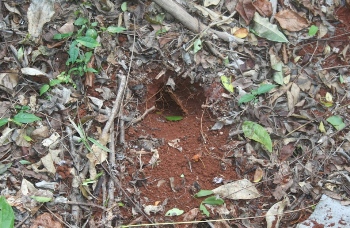 Nose poke of the Hispaniolan solenodon. Photo by: Jose Nunez-Mino. |
Jose Nunez-Mino: I can’t take any credit for this since it was all down to our two local research assistants (Nicolas and LLeyo) who have somehow perfected the art of catching them. Previous attempts at catching them with baited cage traps have proved highly inefficient and unsuccessful. The process developed by our research assistants initially involves finding areas where their distinctive cone shaped “nose pokes” (holes in the ground they make while hunting for insects) look relatively fresh. Returning after dark, we had to sit and wait quietly until we heard their rustlings through the leaf litter. A small chase then ensued through the forest until we could grab the animal by the tail. This sounds awful but from the reaction of the animals this appears to be the most efficient and least distressing method of capture. The animals emit very few alert calls when handled this way although if you try and take hold of them by any other part of the body (with a gloved hand of course) they struggle and emit distinctive alarm calls.
Unfortunately this method may not be suitable for all the environments where the species are found since it relies on having the dry leaf litter to hear them and you definitely can’t catch the animals in this way on very rocky and/or steep terrain. We are working on developing other methods that might be suitable in these areas.
Mongabay Can you tell us about the sounds solenodons make?
Jose Nunez-Mino: I am not an acoustics expert but I can tell you that the sounds they make consist of a series of clicks and high pitched whistles. There has been some suggestion that these may be implicated in echo location but as far as I know there has been no conclusive work in this area. We have managed to make some initial crude recordings of the solenodon which have roused a lot of interest with scientists that work in this area. Plans are developing to hopefully raise some funds to investigate the sounds in order to understand a little more about this aspect of these intriguing animals.
Mongabay What have you discovered is threatening the Hispaniolan solenodon?
and_adult(right).JPG) Hispaniolan solenodon juvenile on the left and adult on the right. Photo by: Jose Nunez-Mino. |
Jose Nunez-Mino: It’s early days yet so we haven’t made any discoveries as such, but we have pretty good clues as to what might be having an impact upon them. The main threat, as always, is deforestation although at this stage we suspect that the Hispaniolan solenodon may be a little more resilient to this than the hutia. However, over the years there have been many reports of solenodon being killed by domestic and feral dogs. Ironically, during a recent interview with a park guard we were told how his dog had killed five solenodon in one night. If this sort of predation is at all typical then this would obviously be having an immense impact.
In the past it has been suggested that the introduced mongoose may be impacting on solenodon populations but there is still a big question mark as to whether or how this might be happening. However, local people do put out poisoned bait to control the mongoose that prey on their chickens. Since solenodon seem to be quite opportunistic in their food choice they may well be feeding and dying from eating the poison bait – an indirect effect that could well explain any potential correlation between mongoose in an area and reduced solenodon numbers. We need to investigate all these threats before coming to any solid conclusions. Right now I would say that it is our lack of knowledge that is posing the biggest threat.
Mongabay How do you think the Cuban solenodon (the only other solenodon in the world) is faring?
Jose Nunez-Mino: The short answer to this question is not very well. Although it used to have a fairly widespread distribution across the whole of Cuba it appears to now be restricted to the Eastern Provinces. It is a very different species to the Hispaniolan solenodon, it is smaller and probably has its own unique niche. There have been some arguments that it should be placed in its own genus. Having said this, we have been in touch with some Cuban scientists in the hope that we might learn from each others experience in studying solenodon and hopefully form a Caribbean wide collaboration in the future with the aim of studying and helping to conserve all the land mammal fauna in this part of the world.
THE HUTIA
Mongabay What is a hutia?
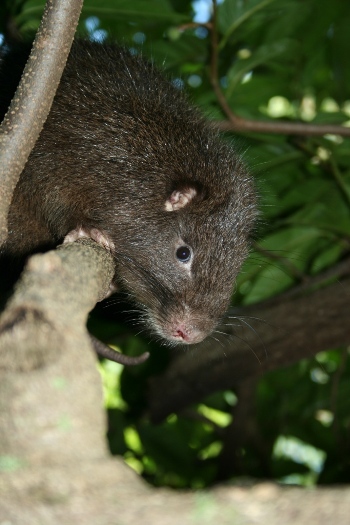 The Hispaniolan hutia peeking out from behind a tree. Photo by: Jose Nunez-Mino. |
Jose Nunez-Mino: We use this exact question in interviews that we carry out with local villagers; unfortunately the term “hutia” is used locally to describe solenodon, hutia or both species. A colleague and friend of mine once described hutia as looking like guinea pig but fatter which is not a bad description although I’d say they are much fatter with adults weighing around 1.2Kg (2.6 pounds). They are very large rodents which usually have brownish fur (the colour can vary in some individuals and populations) which covers their whole body apart from their short tail which is a under a third of their body length. They have broad heads and short rounded ears – very teddy bear like in my eyes.
The species is primarily arboreal and although their tail can hardly be described as prehensile, from what I’ve seen they definitely use it for balance and for extra grip while they are up in the trees. Hispaniolan hutia are nocturnal animals, spending daylight hours in caves or hollowed out trees. The first time I read this I remember thinking how odd it was that an arboreal animal should live in burrows at ground level but having now witnessed their descent from the trees at first light, I can confirm that this is absolutely accurate.
Mongabay What makes the Hispaniolan hutia unique, even among other hutias?
Jose Nunez-Mino: They are the only surviving native rodents of Hispaniola. Although other hutia species are still found in the Bahamas, Cuba and Jamaica, the Hispaniolan hutia is the only surviving member of the Plagiodontia genus which is the oldest lineage of hutia and diverged from the other hutia around 20 million years ago. It is, undoubtedly a very special animal.
Mongabay The hutia makes unique sounds as well, can you tell us about these?
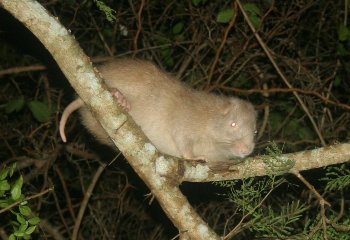 The nocturnal Hispaniolan hutia caught in light at night. Photo by: Jose Nunez-Mino. |
Jose Nunez-Mino: Hutia produce a series of whistles and chirps with their alarm calls having more of a chortling quality about them. Sound is obviously very important for the Hutia, on quiet night you can hear them whistling to each other in the tree tops. Our intrepid field assistants have used this to our advantage by learning to imitate their calls. They use this to both locate animals that would otherwise be hard to see and also to bring them closer to us as the animal’s curiosity gets the better of them. Sounds may prove to be central in our research of the hutia; we have done some initial trials of playback experiments. These have met with limited success so far but the range of recorded calls we have available is fairly limited at the moment. It may yet provide an efficient and effective way of carrying out surveys for this species in the future.
Mongabay What threatens the Hispaniolan hutia?
Jose Nunez-Mino: Hispaniolan hutia are arboreal animals that feed on leaves, fruit, shoots and bark. As such, they are utterly reliant on the presence of trees and forests. Deforestation is likely to be the most direct threat to their ongoing survival. In some areas I have seen evidence of small populations which are surviving in forest fragments set within agricultural landscapes, some villagers are complaining of crop damage and the finger is being pointed at the hutia. The danger is that as the forest becomes increasingly fragmented, not only is the hutia habitat being destroyed but the human-animal conflict could escalate to an all out persecution. This is simply a theory at the moment but something we need to give some serious thought to. The hutia use to be hunted opportunistically as a source of food in the Dominican Republic, in fact in Haiti and for some Cuban species this may still be the case. If human population continues to increase and resources become limited, could this become a more significant future threat to the Hispaniolan hutia?
Mongabay Many of the species of Hutia have already gone extinct—what led to their demise? How about other surviving hutia species—how are they faring, are they receiving any conservation attention?
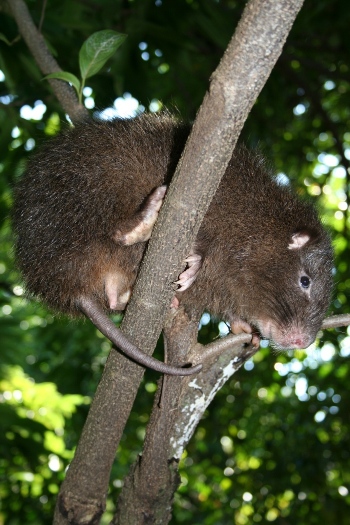 The Hispaniolan hutia hanging out. Photo by: Jose Nunez-Mino. |
Jose Nunez-Mino: The first question is actually a very important one that Dr Sam Turvey from the Zoological Society of London is looking into. We suspect that the other two larger species of hutia in Hispaniola belonging to the Plagiodontia genus may have disappeared after the arrival of Europeans around 500 years ago. Possibly it was human predation or maybe it was because they were specialised species that were lost as deforestation took place; more likely is that it was a combination of both effects. Hispaniola originally had around 98 percent forest cover, Dominican Republic now has around 28 percent and in Haiti the figure is below 4 percent.
The second question is also a tough one to try and answer accurately mainly because of a lack of data. All of the hutia family is endemic to the Caribbean and many are restricted to single islands or groups of islands. The IUCN (International Union for the Conservation of Nature) currently lists six species as Extinct, four as Critically Endangered, four as Endangered (including the Hispaniolan hutia), three species listed as Vulnerable, one as Near Threatened and one of Least Concern. Some of the species listed as Critically Endangered, for example the dwarf hutia from Cuba, have not been seen for over seventy years. Worryingly we know very little about most hutia and for some of the extinct species we do not know what the cause of extinction was. Although many of the hutias have populations within protected areas and legislation that outlaws hunting, this does not inherently mean they are not still potentially in danger from factors such as invasive alien species.
CONSERVATION IN THE DOMINICAN REPUBLIC AND HAITI
Mongabay What are your thoughts on the status of the Hispaniolan solenodon and the Hispaniolan hutia?
Jose Nunez-Mino: The jury is very much out on this question and it lies at the core of the work that we are doing. There is no doubt that their range and numbers have decreased steadily since the arrival of humans on the island. In some areas they are surviving in small forest fragments set in agricultural landscapes. This brings both species into conflict with man in both direct and indirect ways. One would hope that the extensive protected area network in the Dominican Republic will be providing some sort of safeguard but as I mentioned earlier we have already heard of some worrying reports (i.e. dogs) even within these, and in addition there is also some agricultural activity and deforestation within the boundaries of some national parks. Luckily there are several national conservation organisations, including our main project partner “Sociedad Ornitologica de la Hispaniola” who are working very hard to conserve these species and their habitat.
Mongabay What needs to happen to save these species?
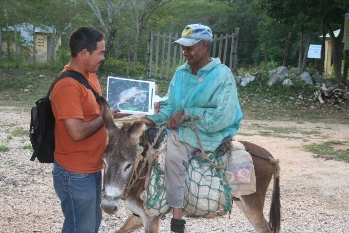 Nicholas, a native research assistant, interviewing a local about the solenodon and the hutia. Photo by: Jose Nunez-Mino. |
Jose Nunez-Mino: It is my belief that the plight of these species, like most, must not be taken out of the wider context. It is not enough to think of ways of saving the species alone but also the environment they live in. First we need to get a better idea of their biology and ecology but while we are doing this we need to, at a bare minimum, hold the line and not lose anymore of the forest habitat that these two species depend on. This is easier said than done of course but potentially these two species could be flagships for the wider conservation efforts in Hispaniola.
Education is also needed in order to make more people at the national and international level aware of the potential dangers involved in losing these species along with their habitat. Imagine the signal it would send to the world if the solenodon, whose lineage has been around for over 60 million years, becomes extinct. Similarly if the hutia, which is the last native rodent of Hispaniola and which has survived despite all adversity, was to disappear. Of course education alone will not save either species or their habitat, conservation efforts need to be carried out within the context of sustainable development. There needs to be a wider realisation that environmental resources are valuable, irreplaceable and finite.
Haiti is already been held up as a world wide example of how disastrous environmental degradation can be [note: interview was conducted before the devastating 2010 earthquake in Haiti]. We do not want to extend this example to the rest of Hispaniola. There is a huge potential to help the situation in Haiti to improve so that it can be held up as an example of how things can be turned round. What’s needed is a collaborative and integrated approach where conservation is not simply seen as a nice sideline, but rather a central requirement as such we need to coordinate our efforts with a wide range of organisations and agencies. This can happen and there are some positive signs that it is happening, within the context of our project we have already received support from a private company, Punta Cana Resort & Clubs, via their ecological foundation.
Mongabay How do local people view the hutia and the solenodon?
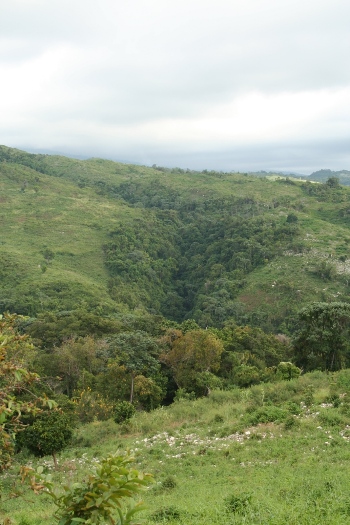 Forest fragment surrounded by agricultural landscape. Photo by: Jose Nunez-Mino. |
Jose Nunez-Mino: One of the first things that struck me when I arrived in the Dominican Republic is how few local people had heard of them. Even in rural communities, the number of individuals who know about or have seen either species is fairly limited; this, I guess, reflects the species’ secretive nocturnal habits. Part of our work involves interviewing people to assess awareness of these species which is followed up with a talk which involves showing them photos and telling them about the natural history we know about. Once you explain that they are found no where else on earth, people generally show an immense sense of pride in them. The hutia suffers from a bit of an image problem since it is a rodent and some photos simply don’t do it justice and make it look like a very large rat, but the differences can be easily explained and understood. The solenodon is thought of as cute by most local people and many suddenly make the connection between the nose pokes they see in some areas and the solenodon snout.
Mongabay What do you hope to discover over the next few years of this project?
Jose Nunez-Mino: Bottom line within the lifetime of the project we need to discover an effective and efficient way to conserve the Hispaniolan solenodon and hutia. This means ascertaining their distribution and abundance at the national scale along with an assessment of the threats which are having an impact now and could possibly do so in the future. Invasive alien species, such as cats, rats and mongoose, are often quoted as potentially having an impact, but we really don’t have a real understanding of how. We need a holistic and integrated approach to monitoring the species in the long term in order to make sure that we really have identified all the threats and start taking measures against them. The picture is likely to be a complicated one, where specific dangers vary from one area to another.
Mongabay How can people help raise awareness and funds to save these strange and wonderful mammals?
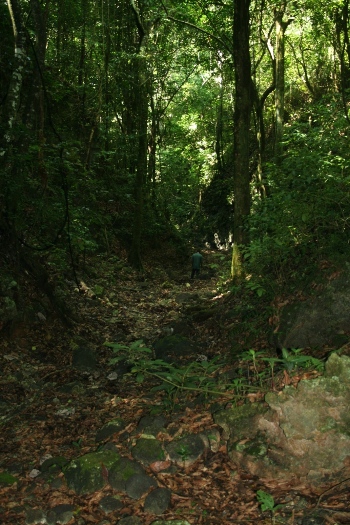 Prime solenodon and hutia habitat: inside a forest fragment. Photo by: Jose Nunez-Mino. |
Jose Nunez-Mino: Although this project will undoubtedly leave its own legacy on the Island of Hispaniola in terms of gathering information, awareness raising and capacity building. I believe that it is crucial that this legacy is a beginning of a process. For this to be true we need to both raise awareness as widely as possible not just at the national level but at the international one too. For the project to reach and continue into the future we want as many individuals or organisations as possible to get involved. How exactly this takes shape will vary in terms of both experience and resources but we encourage and welcome everyone’s contribution. Awareness raising can be done at many different levels, from having conservation issues as a topic of conversation or discussion, through to the more personal contribution of volunteering and experiencing conservation work in the field first hand. If people want to find out about the project and keep up to date with progress they can either follow my blogs on the DWCT website, Evolutionary Distinct & Globally Endangered (EDGE) of Existence website or join the facebook group (The last survivors – Hispaniolan Land Mammal Project).
Unfortunately conservation work does need financial support at least to get the process started. This does not have to take the form of a direct donation to the project, although we obviously welcome these and they can be done through the websites of DWCT or the EDGE of Existence. Other forms of contribution can take the shape of resources (e.g. accommodation or food costs, access to land or provision of training), project promotion (e.g. advertising or contact with people/companies who might want to contribute), expertise (e.g. scientific, educational or social) and equipment (e.g. camera/video, sound recording equipment or radio tracking equipment). I’d encourage anyone who wants to contribute to not hesitate to get in touch. I’m happy to answer any questions or listen to any ideas that people come up with although I would urge them to have patience when waiting for a reply since I am often out in the field.
Nunez-Mino states that interested parties should feel free to contact him at: Jose.Nunez-Mino (at) durrell.org.
A new project website has been set up at: http://www.thelastsurvivors.org/
Solenodon footage shot in the wild. Sounds of solenodon overlaid video.
Hutia footage shot in the wild. Sounds of hutia overlaid video.
Solenodon. Photo by: Jose Nunez-Mino.
Hutia. Photo by: Jose Nunez-Mino.
Interviews with locals at Avia. Photo by: Jose Nunez-Mino.
Sunset in the Dominican Republic. Photo by: Jose Nunez-Mino.
Related articles
Cement mining puts Dominican Republic park at risk
(11/01/2009) A cement mine, granted under questionable circumstances, is putting one the Caribbean’s most important forest parks at risk, warns a group working to stop the project.
Rediscovery of the solenodon, a rare venomous mammal, in Haiti
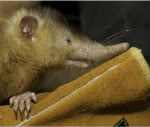
(01/09/2009) In the journal Oryx researchers from EDGE, a program of the Zoological Society of London (ZSL), have announced the rediscovery of a small population of Hispaniolan solenodons in Haiti. At the same time scientists in the Dominican Republic have taken the first ever footage of this endangered mammal.
Europeans may have caused extinction of large mammals in Caribbean
(01/25/2007) New evidence suggests that the arrival of Europeans in the New World corresponds with the extinction of mammal species on the Caribbean islands.
Dominican Delights – Dominica, the real Caribbean
(05/04/2006) Prepare yourself. Here, there are no white sand beaches, no golf courses. Here, you’ll find a boiling lake, winding cliff-side roads, bubbling surf and waterfalls that will make your head spin. This is Dominica, and this is the real Caribbean. Our Easter holiday to this (officially) English-speaking leeward island sandwiched between French neighbors Guadeloupe to the north and Martinique to the south gave us six days to explore enchanting coves, impressive mountains and dozens of rivers. In six short days, we were overwhelmed by Dominica’s charms — her incredible natural beauty and local creole style. Travelers looking to explore and discover, to be educated and reinvented, should consider this an ideal place for a serious Caribbean adventure.
